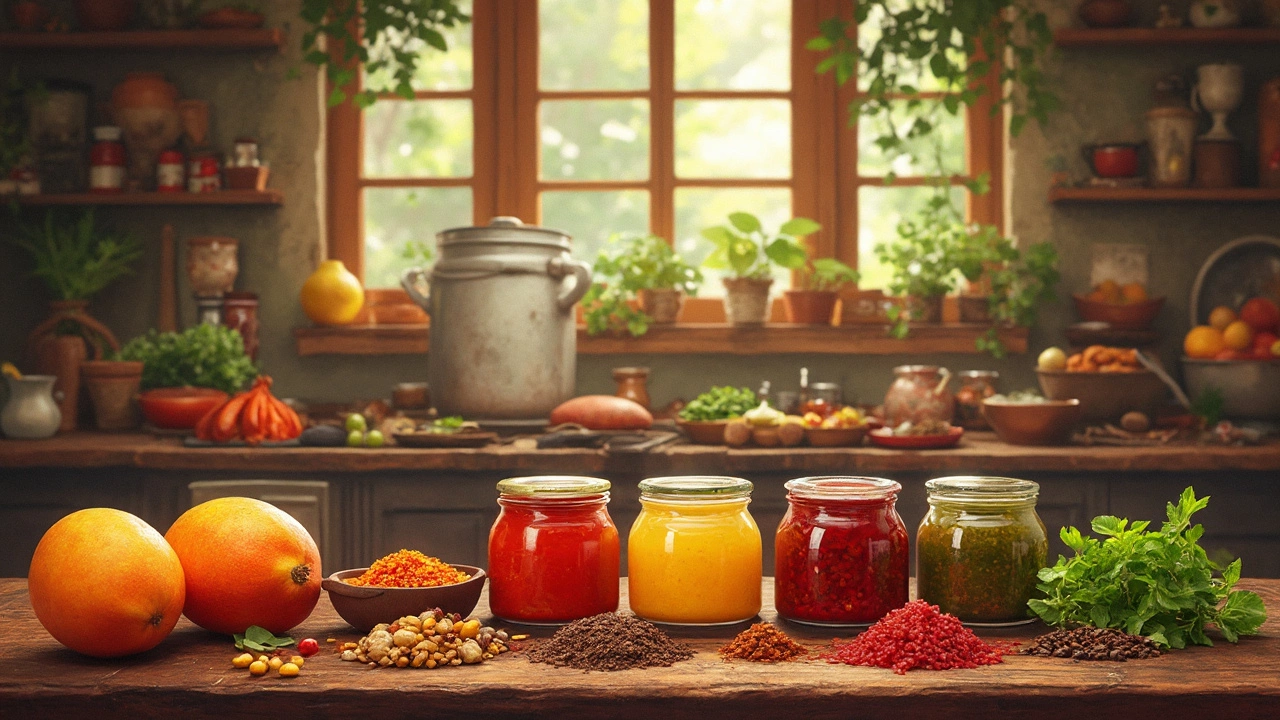Ah, chutney! That vibrant and tasty condiment that seems to give dull meals a burst of life. But, hold your spoon for a moment—let's talk about the not-so-sweet side of this beloved sauce.
First up, flavor overload. Chutney can sometimes take over the taste of a dish completely. We think we're highlighting our food, but in reality, it might just be masking the flavors we genuinely want to enjoy. A subtle misstep, especially if you're trying to impress with that home-cooked meal!
- Flavor Overload
- Hidden Sugars
- Potential Allergens
- Shelf Life Concerns
- Impact on Health
- Alternatives or Solutions
Flavor Overload
When chutney hits the table, it's like a flavor explosion. It's packed with herbs, spices, and often a blend of sweet and sour notes. But sometimes, this explosion can take over in ways we didn't plan. While aiming to boost a dish, some chutneys come off as the star attraction, leaving the main course in the shadows.
This especially happens with strong-flavored chutneys like tamarind or those heavy on garlic. You've got a delicate dish, and suddenly, all you taste is the condiment. It's like wearing a fancy hat that distracts everyone from your fantastic outfit underneath.
Aiming for balance is the trick. Here are a few ways to keep that chutney in check:
- Start small: Instead of slathering it all over your food, begin with a small portion on the side. You can always add more if needed.
- Pair it wisely: Match it with foods that complement its taste. A mild curry or a plain rice might be better companions than something already robust in flavor.
- Experiment: Not all chutneys fit every dish. Try different types with various foods to discover what works best.
Remember, the goal here isn't to make chutney the headliner but a part of a well-orchestrated culinary symphony. By understanding how to balance flavors, your meals will shine, and what used to be a potential disadvantage becomes a flavorful asset.
Hidden Sugars
Here's a scoop: your favorite chutney might just be a sugar bomb in disguise. Yep, even that tangy, spicy blend you love can have more sugar than you'd guess. It's especially true if you buy it from the store, where added sugars are often used as preservatives to enhance flavor and extend shelf life.
For example, just a couple of tablespoons of some mango or tomato chutneys can contain 4-8 grams of sugar, which is about one to two teaspoons. That might not sound like much—but think about how quickly those tablespoons can add up when you're piling it onto your plate!
Staying aware of these chutney disadvantages could be a game-changer if you're watching your sugar intake. Keep a close watch on the ingredient list and nutrition facts on the label. Words like 'corn syrup', 'fructose', or 'cane sugar' are a dead giveaway that your chutney's sugar content is boosted.
If you're a DIY fan, making your own chutney recipes at home can be a healthier option. Use natural sweeteners like honey or fruit purees, and you can control just how sweet you want it to be. That way, you enjoy all the taste with none of the guilt, keeping your health and heart happy.
Potential Allergens
Ever tucked into a delicious bite of chutney and felt a tickle in your throat? If yes, you might have encountered one of the less charming sides of this zesty condiment. Chutneys often contain a mix of spices, fruits, and nuts, making them a minefield for those with potential allergens.
Common culprits include nuts like peanuts or almonds, which are often used to add texture and richness. If you have a nut allergy, it’s essential to check the ingredients or verify with the maker about the contents. It’s surprising how easily nuts can sneak into the mix!
Then there are the spices. While spices like cinnamon and mustard seeds give chutney its signature punch, they can also pose allergy risks. Mustard seed allergies are less common but can lead to serious reactions.
Even fruits used in chutneys aren’t always safe. Mango, for instance, is a frequent offender in chutneys, and some folks might find themselves reacting to it without warning.
This isn’t just hearsay. According to a study on food allergies, a significant number of reactions stem from unsuspected ingredients often found in condiments like chutney.
- Always read labels carefully.
- Consider making chutney at home where you can control what goes in.
- When dining out, don’t hesitate to ask about the ingredients, even if the chutney sounds 'safe.'
Being aware of these potential allergens means you can avoid unwanted surprises while still enjoying the flavorful addition that chutney brings to your dish!

Shelf Life Concerns
Let's be honest—most of us don’t finish a jar of chutney in one go, and that’s where the shelf life worries creep in. Chutney might not visibly spoil like milk or eggs, but it's still sneaky when it comes to going bad.
The thing is, once you open that jar, the clock starts ticking faster. Even with that reassuring pop of a freshly opened jar, bacteria and mold know how to spoil the party over time. Store-bought chutneys usually contain preservatives, but even they have their limits.
The safest bet? Keep chutney in the fridge after opening, and try to use it within a month, tops! For homemade versions, which often lack preservatives, aim for a couple of weeks in the fridge. If you’re unsure whether it's still good to go, let your nose and eyes be your guide—if it smells funky or if there’s any mold peeking out, ditch it.
A quick tip: always use a clean, dry spoon to avoid contaminating the chutney, and make sure the jar is sealed tightly after every use. These small habits can help stretch out the chutney’s life a bit longer.
Impact on Health
Alright, let’s dig into how chutney can play tricks on your health. While it's delicious, it isn’t always a friend to your body. You see, many store-bought options are packed with added sugars to give them that irresistible taste, which can sneak up those calorie counts pretty fast. High sugar intake isn’t just about the extra calories; it’s a pathway to concerns like weight gain and even a spike in blood sugar levels. Not ideal if you're trying to watch your diet!
On top of that, let's talk sodium. Salt is a key player in many chutney recipes, which helps preserve the chutney and enhance its taste. But this salty treat can contribute to increased blood pressure if eaten without consideration. If you're already watching your salt intake, you might want to be mindful about how much chutney you're piling on.
And oh, the lovely food colorings. Some brands like to use artificial colorants to make their chutneys look vibrant and fresh. While they sure look tempting, these artificial additions might not be so great for everyone, especially if you’re sensitive to such ingredients.
To help you out, here’s a quick look:
| Concern | Potential Effect |
|---|---|
| Sugar | Weight gain, increased blood sugar |
| Sodium | High blood pressure |
| Artificial Colorings | Sensitivity reactions |
Knowing these downsides doesn’t mean you have to skip chutney altogether. Homemade chutneys are an alternative, allowing control over ingredients, especially cutting down on sugar and salt. Or, simply look for brands that prioritize natural ingredients and have transparent labeling. There’s always a way to enjoy your chutney without compromising your health!
Alternatives or Solutions
Alright, so chutney might have its downsides, but that doesn’t mean you have to toss it out altogether. Instead, let's dive into some smart alternatives and solutions. You'll get the flavor punch without the pitfalls!
If you're worried about those hidden sugars, try making chutney at home. This way, you control what goes in. Use ripe fruits but skip the sugar. A dash of lemon or lime can add zest without unhealthy extras.
Concerned about potential allergens? Opt for more straightforward ingredients and steer clear of nuts or other common culprits. Experiment with veggie-based chutneys like tomato or bell pepper, which are both fresh and flavorful.
When it comes to extending that tricky shelf life, refrigerating and properly sealing your chutney can help. Use clean utensils to avoid contamination when serving.
According to a culinary expert from Spice Up Magazine, "Making your own chutney allows for customization to dietary needs, ensuring a delightful yet healthy experience."
Want alternatives to chutney's intense flavors? How about trying simple yogurt-based dips or a light vinaigrette? These can complement your dishes without overpowering them.
- For sweet alternatives, think apple or pear butter;
- For savory options, consider pesto or hummus.
So there you go! With these tips and tricks, you can still enjoy the joys of chutney without the worries. Happy experimenting!
